
How establishing world-class quality assurance practices will see you through S/4HANA migrations and beyond
Discover how to ensure a seamless SAP S/4HANA migration with high-maturity quality assurance practices. Learn strategies to minimize risks, enhance innovation, and maintain stability post-migration.

With today’s accelerated innovation and rapidly changing market dynamics, businesses must continuously evolve to maintain their competitive edge and keep up with trends. This means that ongoing development and changes will never cease. New business models and technologies drive and necessitate new IT innovations and digital transformation and vice versa.
SAP’s latest enterprise resource planning (ERP) system SAP S/4HANA helps businesses stay ahead of the curve by leveraging advanced technologies and a future-ready infrastructure. It enables agility, innovation, and competitiveness in a rapidly evolving market.
While the benefits to be gained by migrating to S/4HANA are numerous, these digital transformations are complex, multi-year projects that require significant investment. Not only must organizations effectively manage migration and implementation—which includes staying on budget and schedule, avoiding business operation disruptions or downtime, and organizing resources efficiently—they must also plan to quickly innovate and meet expectations after the migration.
To address these challenges, organizations need the right quality assurance (QA) strategy and operating model to safeguard large migration projects and the accelerating pace of innovation that takes place afterwards.
In this blog, we will outline high-maturity QA practices and how to apply them to your business as a catalyst for transformation.
QA is more than just tools
Often when we think about QA and establishing a QA practice, we focus on the tools and the technology. There are many great tools available, offering functional capabilities for different parts of QA. But it’s also important to think about it more holistically and consider the right processes, people, and technologies that make up your operating model.
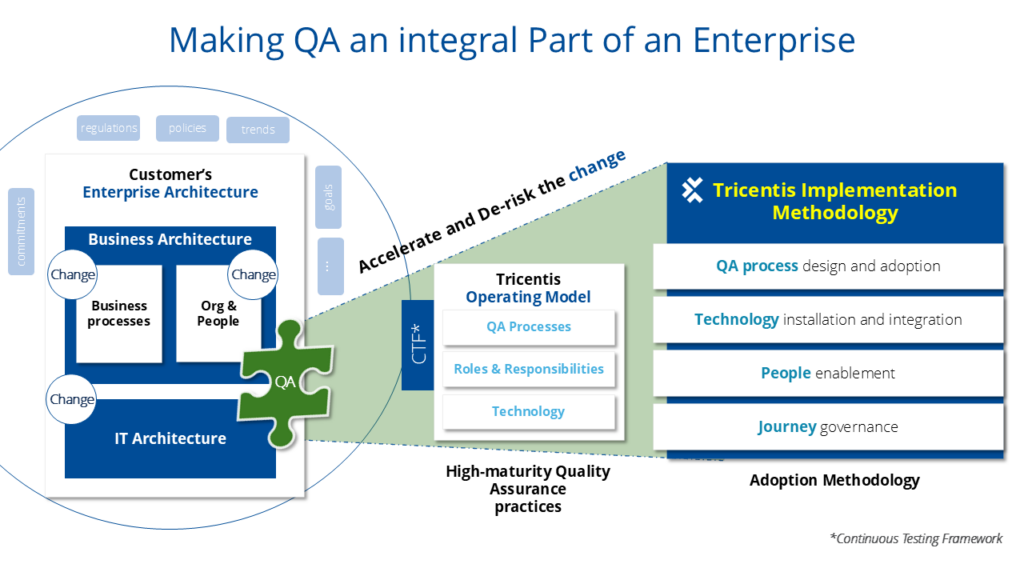
High-maturity quality assurance practices are built around three key pillars:
- Solid QA processes – best practices and end-to-end quality assurance methods
- Roles & responsibilities – the people responsible for upholding and improving best practices
- Technology – the software testing products the people utilize to accomplish their QA goals
This blog covers what you’ll need to establish a high-maturity quality assurance practice at your company for each of the areas mentioned above. Then, we’ll dive into how you can use the Tricentis Implementation Methodology (TIM) to adopt and effectively implement your practice. We’ll use transformation from ECC to S/4HANA as a real-world example.
Recommended QA best practices in the context of SAP Activate
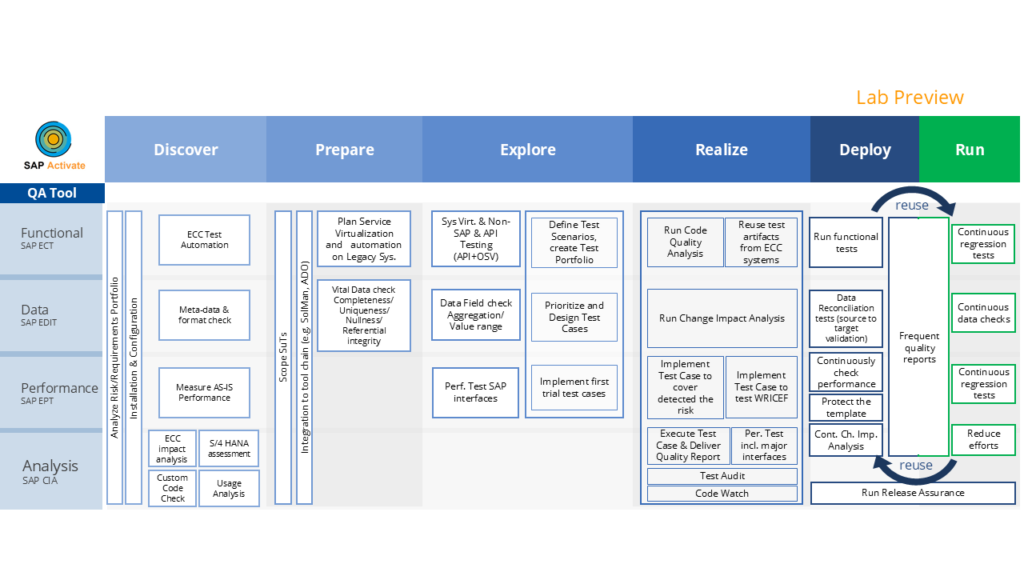
At Tricentis we have several tools that help safeguard your digital transformation journey by automating your functional testing, conducting change impact analysis, verifying your data integrity, and enabling you to run load testing. We have mapped these to the SAP Activate methodology framework above.
These solutions include the following and are also available as Solution Extensions from SAP:
| Tricentis Product | SAP Solution Extension |
|---|---|
| Tricentis LiveCompare | SAP Change Impact Analysis by Tricentis |
| Tricentis Tosca | SAP Enterprise Continuous Testing by Tricentis |
| Tricentis NeoLoad | SAP Enterprise Performance Testing by Tricentis |
| Tricentis Data Integrity | SAP Enterprise Data Integrity by Tricentis |
Let’s start with what you can do from a QA perspective with Tricentis Solutions in SAP Activate’s Discover phase.
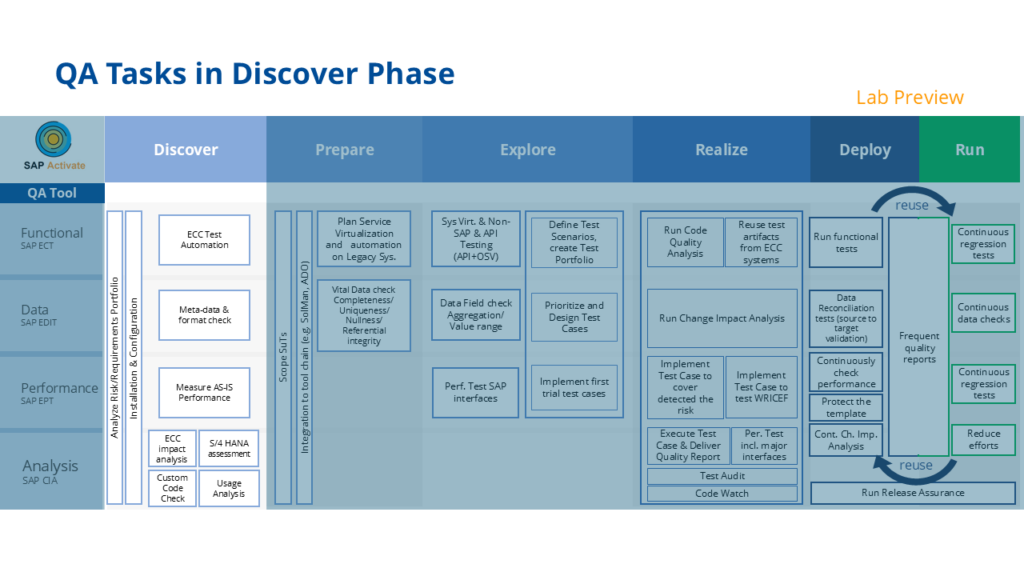
Discover
In SAP Activate’s Discover phase, Tricentis solutions can help you define the correct scope of a migration and identify potential risks early on.
With LiveCompare’s S/4HANA assessment, you can analyze your existing business processes and data, determine which are used frequently, and assess how critical they are for your company. You can then decide what processes and data should be migrated to your S/4HANA instance. LiveCompare can also help you understand if these selected processes and data meet the criteria for S/4 or what needs to be done to ensure they can be migrated to S/4.
With LiveCompare, you can also gather information about custom code, assess its criticality, and decide if, and when, it should be migrated or retired. Additionally, you can collect information about permissions on objects for different users and use this information to design your future authorization concepts.
As you begin your migration in the Discover phase, you may need to consolidate multiple ECC systems to S/4HANA. Compiling data from multiple sources can quickly become complicated. Tricentis Data Integrity can be used to compare metadata and determine the data quality across different ECC systems, giving you insights to plan data migration activities.
Since ECC will coexist with your new S/4 systems for quite some time, changes will occur, and these changes will also need to be monitored and tested. They may eventually be migrated to your S/4 instance in the future.
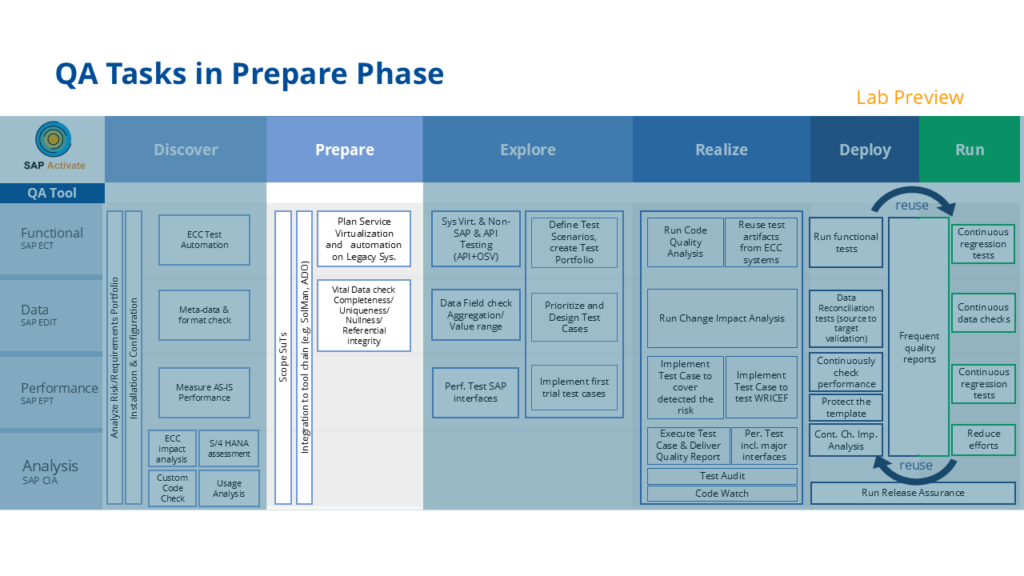
Prepare
In SAP Activate’s Prepare phase, the focus is on defining the scope of the project, building the project organization, enabling the team, and prototyping.
At this stage the QA team should already be considering testing methodology and concepts, how they want to execute testing on both ECC and S/4, how to compare the two systems, and how to reuse as many test artifacts as possible for both systems.
For large projects with multiple work streams, where the QA team (even a test center of excellence) with multiple testers, architects, and test analysts need to support quality assurance activities, you should define an operating model and playbook with QA processes, roles, quality criteria, and KPIs. This ensures everyone knows their role, what exactly is expected from them and when, and what the collaboration model looks like for system integration, E2E, and UAT.
Tricentis solutions should be integrated into your CI/CD pipeline, so that everything from requirement definition to triggering tests, reporting, and analytics runs in an integrated toolchain.
Lastly, in this phase, you can already automate test cases and define service virtualization and API testing scenarios for non-SAP/legacy systems. Service virtualization is a way of simulating systems that are not available for testing (e.g., due to high costs) during end-to-end testing. You can also define API testing scenarios to test existing external APIs for the new S/4 system.
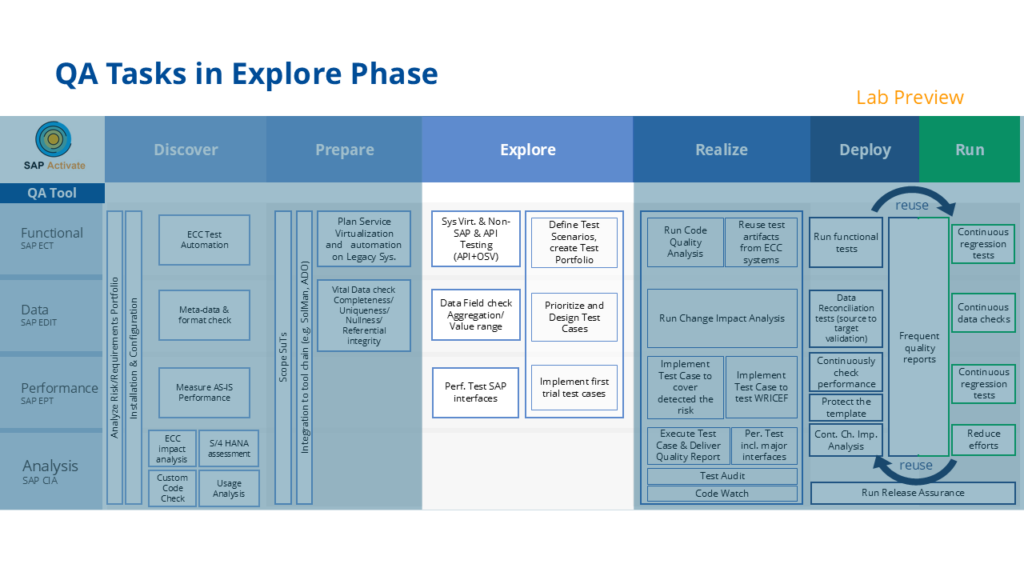
Explore
In the Explore phase of SAP Activate, it’s crucial from a QA perspective to foster strong collaboration among stakeholders, based on the QA playbook created in the previous phase.
If team members are unclear about their roles, unsure how to use QA tools, or don’t know who to collaborate with and why, it becomes difficult to achieve the desired outcomes. That’s why it’s essential to ensure that all stakeholders understand their roles as defined in the playbook, and everyone has received adequate training on the QA tools being used.
By this phase, you should have:
- Established your QA processes
- Installed the necessary QA tools
- Enabled stakeholders for their specific QA responsibilities
Now, the Fit-to-Standard workshops take place as per the SAP Activate roadmap. These sessions help identify any deviations from SAP standard processes, giving you a clear picture of the project scope and any customizations needed to address any misalignment.
With the insights derived from the workshops you can begin designing your test portfolio and drafting test cases.
Collaborate with business users and process owners to prioritize the test cases and focus your resources first on those with the highest impact. You should also consider the results from LiveCompare’s Most-At-Risk analysis and determine whether it is worth investing resources to automate or even test certain test cases.
Additionally, in this phase, you can already automate test cases for non-SAP/legacy systems and implement service virtualization and API testing scenarios.
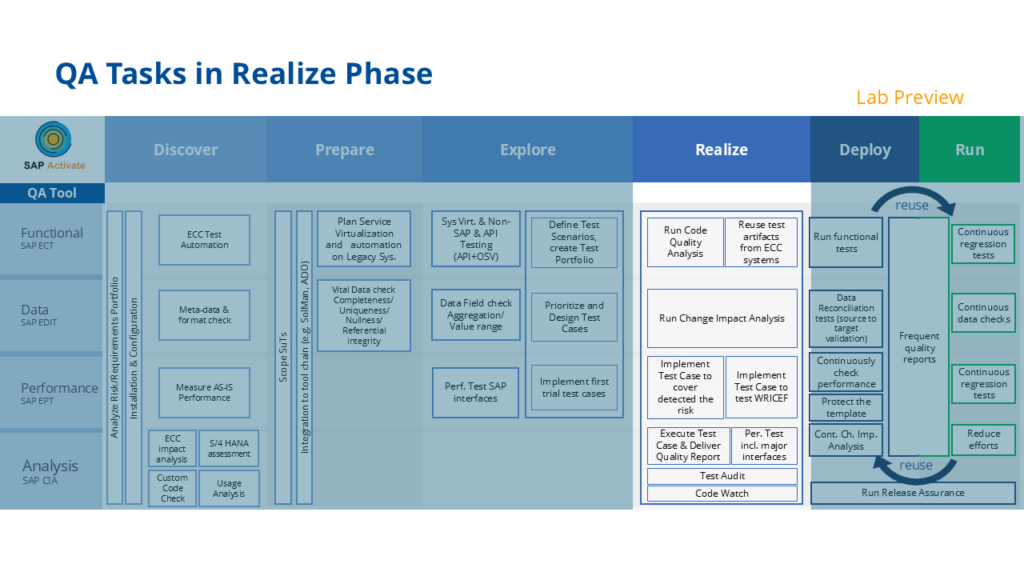
Realize
In SAP Activate’s Realize phase your focus is on the continuous development of S/4HANA, meaning continuous quality assurance is vital. Quality assurance should begin as ABAP developers write their code. LiveCompare analyzes the ABAP code to ensure it meets S/4HANA code quality criteria. Additionally, with LiveCompare, your ABAP developers or CharRM managers can continuously perform code quality analysis, catching defects during code development before functional testing begins. This allows for immediate defect resolution during the coding phase.
Through continuous change impact analysis with LiveCompare, you can constantly optimize your testing efforts. You can identify which new changes need to be tested, check if a test case already exists, and either execute it or automatically add it to the automation specialist’s backlog for future automation.
From this point onward everything becomes a continuous process. Keep in mind that if you are developing test cases for ECC, you can reuse these test cases for S/4HANA thanks to model-based testing available in Tricentis Tosca.
At this phase you can also start testing the performance of critical APIs. Functional test cases developed for ECC can be reused as a basis for performance testing in Tricentis NeoLoad, helping you cut development costs of new performance tests.
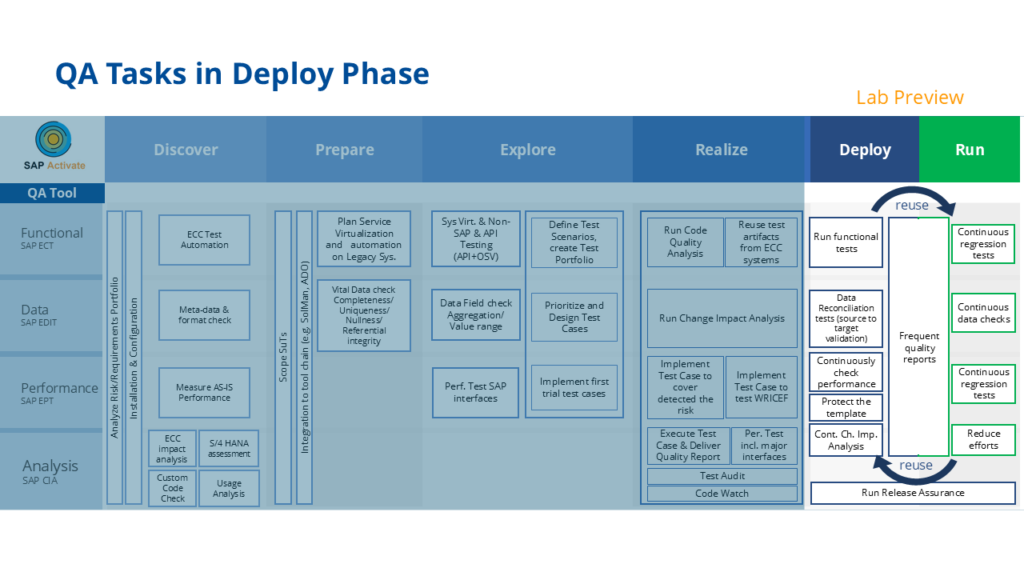
Deploy & run
From SAP Activate’s Deploy phase onward, your focus is on continuous testing and creating data-rich reports and making data-driven decisions about what goes into production and what does not.
By implementing continuous quality assurance, you can dramatically shorten or potentially even eliminate the hypercare phase that typically follows the deployment of a new feature or an update.
If parallel local rollouts are happening at this stage, you can control whether the local rollouts are still compliant with the global template.
Through defined data checks, you can ensure that master data remains valid and suitable after the migration and implementation of new processes.
As your system and the data within it grows, it is highly recommended to conduct performance testing in addition to functional testing to monitor whether your system can handle the expanding load.
Continuous change requires continuous testing
Once you have completed your S/4HANA transition, change will not end there. In fact, it is just the beginning. You will be operating S/4HANA and many other integrated third-party systems in your IT landscape for many years. New innovations, updates, upgrades, and new processes will continue to come, which means you will experience continuous change.
And to manage continuous change, you will need to conduct continuous testing. The good news is that the test artifacts you developed during the implementation can be reused. Furthermore, by having a high-maturity quality assurance practice in place, you will have no problems in managing and safeguarding all of this change going forward.
How to implement the QA practices
Knowing which QA practices you need to establish for your SAP journey is only half the battle. You will also need to know how to implement those best practices in your QA organizations to smoothly complete your S/4HANA transformation and proceed with continuous testing thereafter.
We use SAP Best Practice Content and SAP Activate as example frameworks to best illustrate how to set up your QA practice. SAP best practices help you know which business processes you will need, and SAP Activate shows you how to implement them.
Tricentis Implementation Methodology
Our consulting services have helped our customers establish successful QA organizations and practices in over 1,000 engagements. We have taken all the experience and lessons learned from these engagements and synthesized and formalized them into a framework that we call Tricentis Implementation Methodology.
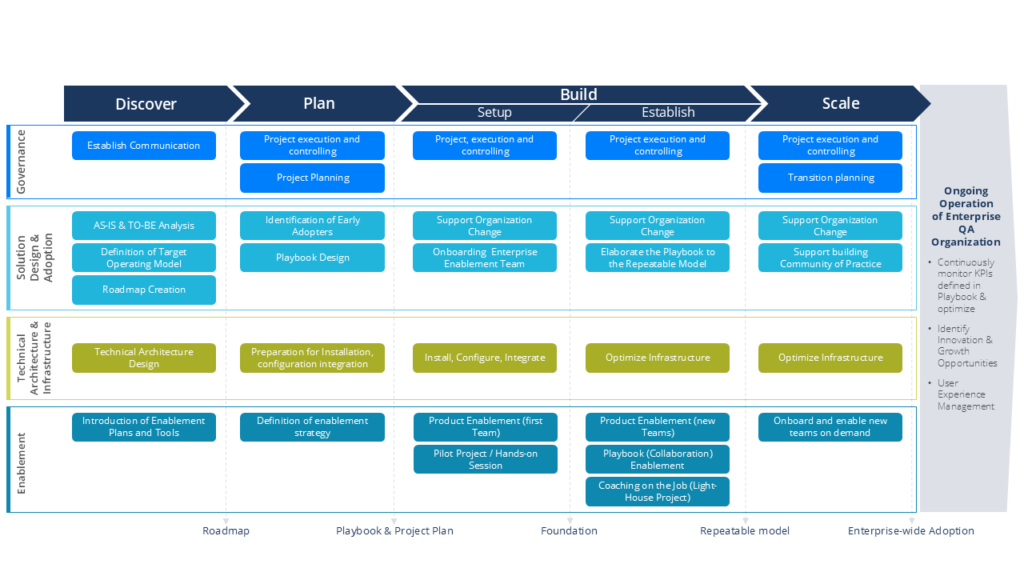
You can see a high-level overview of this framework above. As mentioned previously, we built this framework in alignment with the discrete phases of the SAP Activate methodology with some modifications:
- We identified the work that needs to be done and separated implementation tasks into four phases. The build phase has two sub-phases. The two sub-phases take into account user adoption, which is explained in more detail later.
- The framework was designed so that at the end of each phase, you have a tangible deliverable that provides you with some key value. “Rome was not built in a day,” and neither is a world class quality assurance practice. So, the intention is to incrementally build on each phase to increase the maturity of your QA organization and adoption of QA best practices.
- We have allocated the responsibility for these tasks across four workstreams according to the knowledge and experience needed to execute those tasks.
To learn more about TIM, feel free to get in touch with our Professional Services who are happy to assist you with anything you need.
Maturity and business value growth over time
As mentioned above, Tricentis built the TIM framework with the intention of delivering a tangible key deliverable at the end of each phase. In the illustration below, you can see the progress of QA maturity and business value over time.
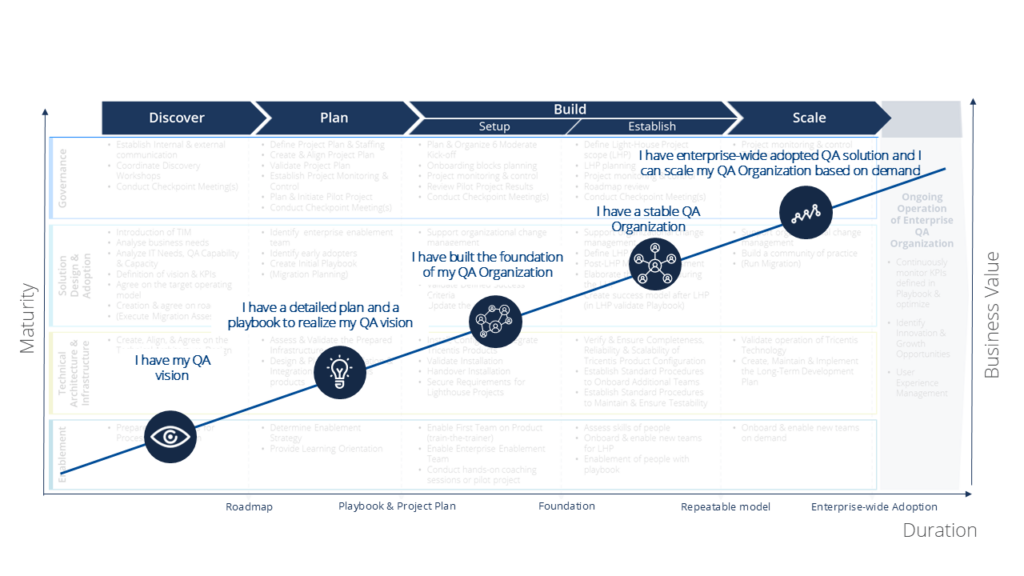
Discover
At the end of the Discover phase, you will have a vision of how the future of your QA organization should look. More importantly, you will have a roadmap showing how to reach that vision, explaining what you can achieve by when, including a clear list of what resources you will need.
Plan
At the end of the Plan phase, you will have a detailed project plan and specification for your QA operating model with end-to-end QA processes, roles, governance, and enablement strategies. This is basically your entire QA playbook. In SAP language, you can call it the blueprint of the organization.
Build-setup
At the end of the Setup phase, you will have installed and integrated your required QA tools. You will also have a core team in place that has studied and adopted the playbook and is working with the QA tools productively. This team will act as the trainers or enablers for the rest of the organization. Essentially, this is the foundation of your QA organization.
Build-establish
At the end of the Establish phase, you will have established all your QA processes. Furthermore, your core team will have enabled several additional teams who know how to collaborate according to the playbook. Everything is stable, and you will have a proven, productive, and repeatable model.
Scale
Now that you have your QA practice and solutions built and established, you are ready to scale it based on demand. An enterprise-wide accepted and adopted process allows you to easily onboard new people and repeat the model in other instances when needed.
User adoption throughout the implementation journey
As mentioned previously, we have divided the build phase into two sub-steps – setup and establish. The reason for this is that we are considering the common ways in which users adopt new processes and technologies. Afterall, the success of any model of this kind heavily depends on how well the organization adopts it.
When we map the anticipated user adoption on the implementation journey, it looks as follows:
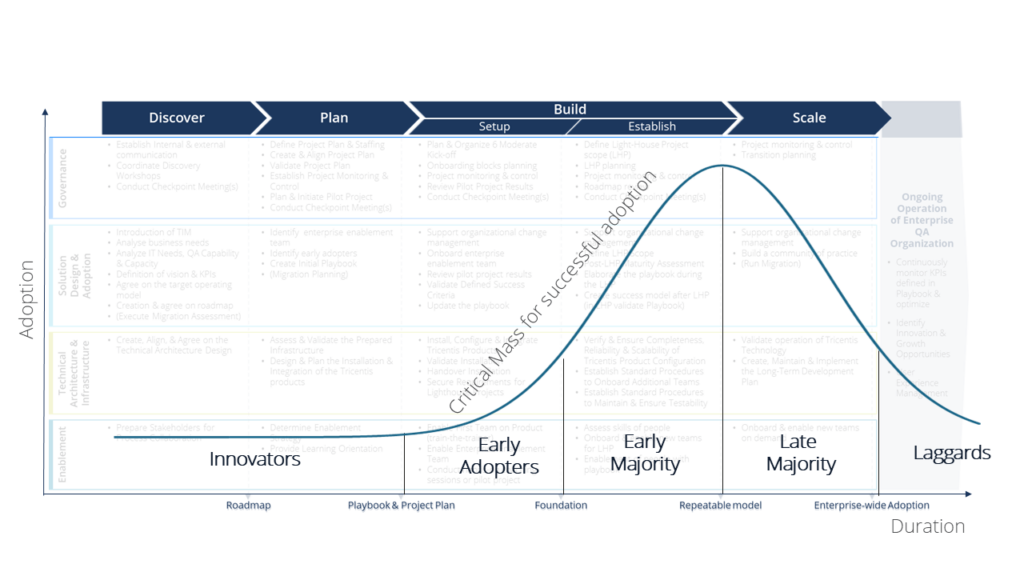
The Law of Diffusion of Innovation explains the adoption rates of new ideas through five distinct user segments according to their readiness to change. This can be a useful framework to apply when building your QA team.
The law states that 1-3% of your target users are innovators. They live for innovation and wish to be involved in designing and implementing new innovations. These are the people you want to work with at the early stages of your implementation when designing the QA solution.
An estimated 10-15% are early adopters who like to be the first to try new things. This is your core team, and these are the people you want to engage with during the setup portion of the build phase. Together with the innovators, these are the people who will enable the early majority during the Establish phase. The early majority are the 30-35% who are ready to adopt change if they see the benefit.
By the end of the Establish phase you have reached critical mass of adoption of the QA solution, which facilitates the success of further adoption and getting the late majority and laggards onboard.
Key properties of Tricentis Implementation Methodology
The Tricentis Implementation Methodology is a people-centered approach to setting up a new QA organization or refreshing your existing one. In this post, we have described the methodology within the context of SAP transformations. However, this methodology is ultimately platform agnostic and can be utilized to establish a high-maturity QA organization regardless of the platform. Key principles of TIM include:
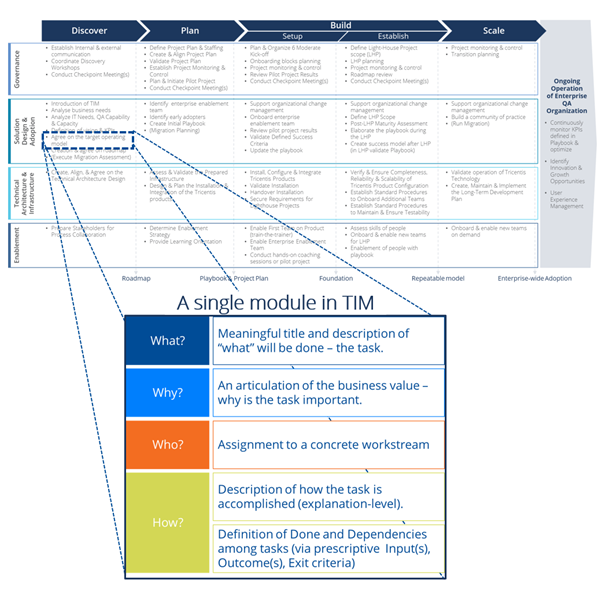
A holistic implementation approach: TIM is a strategic, holistic approach that defines implementation work from beginning to end to achieve a comprehensive and integrated solution. It’s valuable to organizations because it considers all QA aspects, including people, processes, and technology. The framework aims to transform how businesses deploy Tricentis solutions, making them more efficient, effective, and aligned with their digital transformation goals.
A modular and adaptable framework: TIM enhances project delivery by providing a proven yet flexible framework that is tailored to each organization’s unique challenges. It ensures the necessary work is done and can be adapted to every situation. This is achieved through concrete definitions of modular and adjustable tasks, as well as clear definitions of relations among them, encompassing expected input and output. The framework aims to elevate delivery efficiency and quality, ensuring solutions meet an organization’s immediate and long-term objectives.
A foundation for consistent delivery quality: TIM standardizes Tricentis solution implementation processes as well as the enablement processes for both Tricentis and partner consultants. By establishing clear guidelines and best practices, TIM ensures consistency and quality across all engagements, ultimately enhancing customer satisfaction and loyalty.
A common language among delivery stakeholders: TIM acts as a common language, facilitating easy communication across all levels of Tricentis, our partner ecosystem, and our customers. This ensures that everyone involved in the implementation process is on the same page, fostering collaboration and efficiency at every step.
Conclusion
Establishing a high-maturity quality assurance organization is crucial for successfully navigating the complexities of S/4HANA transformations and ensuring the ongoing stability and innovation of your business operations. As we have explored throughout this blog post, a comprehensive QA strategy that integrates the right tools, processes, and people not only mitigates risks and avoids disruptions but also drives innovation and efficiency.
By adopting a holistic approach and leveraging frameworks such as the Tricentis Implementation Methodology and SAP Activate, organizations can effectively manage both the immediate challenges of digital transformation and the continuous changes that follow. As you move forward with your S/4HANA journey, remember that quality assurance is not just about preventing defects; it’s about enabling your business to evolve confidently and maintain a competitive edge in a rapidly changing digital landscape. The investment in robust QA practices today will pay dividends in fostering sustainable growth and agility for years to come.